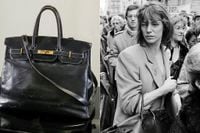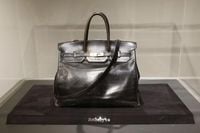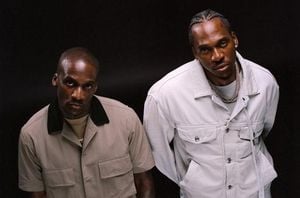In a dazzling display of luxury and history, the original Hermès Birkin handbag, designed for the late British actress and singer Jane Birkin, sold for an astonishing €8.6 million (£7.4 million; $10.1 million) at Sotheby's auction in Paris on July 10, 2025. This sale not only set a new world record for the most valuable handbag ever sold at auction but also marked the bag as the second most expensive fashion item ever auctioned, trailing only behind the iconic ruby red slippers worn by Judy Garland in The Wizard of Oz.
The original Birkin bag's journey began in 1984 during a chance encounter on a Paris-to-London flight. Jane Birkin, then a young mother struggling to find a handbag roomy enough for her daily essentials, was seated next to Jean-Louis Dumas, the chairman of Hermès. Frustrated with the limited options available, Birkin expressed her need for a larger, more practical bag. Dumas, ever the creative visionary, quickly sketched a spacious rectangular holdall on the back of an airplane sick bag, featuring a burnished flap, saddle stitching, and dedicated compartments for baby bottles.
This sketch led to the creation of the prototype that would become the legendary Birkin bag, first presented to Birkin in 1985. The bag was named in her honor after she gave her permission, and Hermès began producing it commercially. Over the years, the Birkin bag evolved into a symbol of exclusivity and status, coveted by celebrities such as Kate Moss, Victoria Beckham, Khloe Kardashian, and Jennifer Lopez. Its allure stems not only from its craftsmanship and design but also from its scarcity—Hermès maintains strict control over production, resulting in years-long waiting lists and a complex purchasing process that requires personal boutique visits and often, sales associate discretion.
The prototype sold at Sotheby's was distinct from later commercial versions, featuring unique characteristics like a non-removable shoulder strap, closed metal rings, and an attached nail clipper—a nod to Birkin's personal style and needs. The bag bore Birkin's initials, "J.B.," embossed on the front flap and exhibited faint adhesive marks from stickers she applied to support humanitarian causes such as Médecins du Monde and UNICEF. Sotheby's described the bag's condition as reflecting many years of use by Birkin herself, who owned it for a decade before selling it in 1994 to raise funds for AIDS research.
The auction drew intense interest, igniting a ten-minute bidding war among nine determined collectors. The bidding opened at €1 million, eliciting audible gasps from the room, before the final hammer fell at €8.58 million, inclusive of commission and fees. The victorious bidder was a private collector from Japan, who outpaced eight rivals, including Lauren Sánchez, a well-known figure in luxury circles who was reportedly the runner-up.
Morgane Halimi, Sotheby's global head of handbags and fashion, hailed the sale as a "startling demonstration of the power of a legend," emphasizing the bag's role as the genesis of an extraordinary story that transformed the Birkin into the most coveted handbag in the world. She remarked, "It is incredible to think that a bag initially designed by Hermès as a practical accessory for Jane Birkin has become the most desirable bag in history and will most likely continue to be so for many years to come." Sotheby's further noted that this sale set records not only for handbags but also for the most valuable fashion item sold at auction in Europe and the costliest luxury item ever sold at Sotheby's Paris.
Jane Birkin herself was a celebrated figure in both British and French cinema, known for roles in classics such as La Piscine and Blow-Up. Despite the bag bearing her name and becoming a global icon, Birkin reportedly found the bag "too heavy" to carry later in life, preferring instead to fill her pockets in a more practical manner. She received several Birkin bags as gifts from Hermès throughout her life and generously donated proceeds from sales of some to charitable causes.
The original Birkin bag's provenance is notable. After Birkin sold it in 1994, it was purchased at auction in 2000 by Catherine Benier, a Paris-based luxury boutique owner, who kept it for 25 years before consigning it to Sotheby's. Benier expressed nostalgia and happiness that the bag found a new loving home after the sale, calling it the "jewel in my collection." The bag also featured in exhibitions at prestigious institutions like the Museum of Modern Art in New York and the Victoria & Albert Museum in London, underscoring its cultural significance.
The Birkin bag's exclusivity and desirability have sometimes sparked controversy. In 2024, frustrated consumers in the United States filed a class-action lawsuit against Hermès in California, alleging unfair purchasing practices due to the brand's restrictive sales policies and years-long waiting lists. Meanwhile, Birkin herself had a sometimes strained relationship with Hermès, particularly concerning the company's use of crocodile skins, once threatening to remove her name from the bags over animal welfare concerns.
Today's staggering auction price reflects not only the bag's rarity and craftsmanship but also its rich history and cultural cachet. It far surpasses the previous handbag auction record set in 2021 by the Hermès white Himalaya niloticus crocodile diamond retourné Kelly 28, which sold for $513,040 (£380,000). The Birkin's status as a fashion icon is cemented, having evolved from a practical solution sketched on an airplane sick bag to a symbol of luxury and aspiration worldwide.
As the fashion world continues to oscillate between understated elegance and ostentatious displays, the Birkin remains a constant marker of prestige. Its journey—from Jane Birkin's personal accessory to the most expensive handbag ever sold—illustrates how a simple conversation and a quick sketch can spark a global phenomenon that transcends fashion, embodying heritage, exclusivity, and the enduring allure of craftsmanship.






